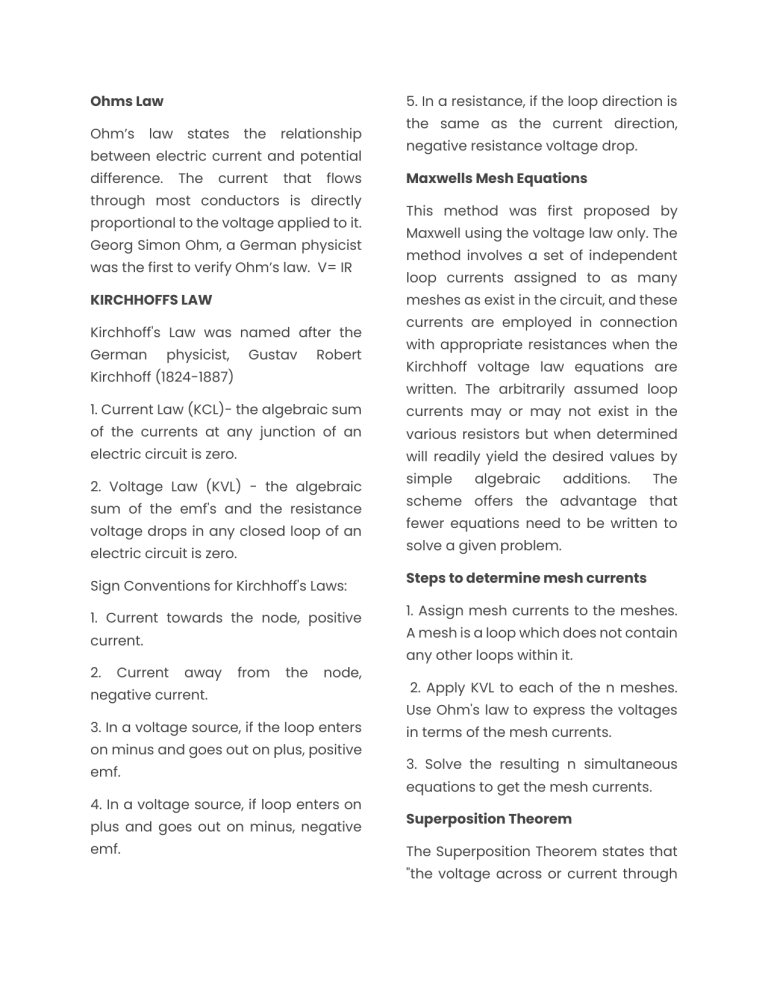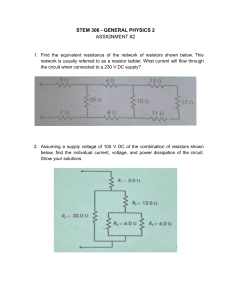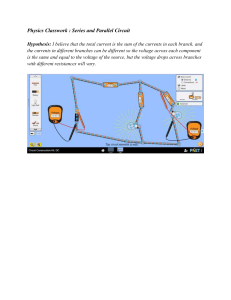Electrical Engineering Fundamentals: Ohm's & Kirchhoff's Laws
advertisement

Ohms Law Ohm’s 5. In a resistance, if the loop direction is law states the relationship between electric current and potential difference. The current that flows through most conductors is directly proportional to the voltage applied to it. Georg Simon Ohm, a German physicist was the first to verify Ohm’s law. V= IR KIRCHHOFFS LAW physicist, negative resistance voltage drop. Maxwells Mesh Equations This method was first proposed by Maxwell using the voltage law only. The method involves a set of independent loop currents assigned to as many meshes as exist in the circuit, and these Kirchhoff's Law was named after the German the same as the current direction, Gustav Robert Kirchhoff (1824-1887) currents are employed in connection with appropriate resistances when the Kirchhoff voltage law equations are written. The arbitrarily assumed loop 1. Current Law (KCL)- the algebraic sum currents may or may not exist in the of the currents at any junction of an various resistors but when determined electric circuit is zero. will readily yield the desired values by 2. Voltage Law (KVL) - the algebraic sum of the emf's and the resistance voltage drops in any closed loop of an electric circuit is zero. Sign Conventions for Kirchhoff's Laws: 1. Current towards the node, positive current. 2. Current away from the node, negative current. 3. In a voltage source, if the loop enters on minus and goes out on plus, positive emf. 4. In a voltage source, if loop enters on plus and goes out on minus, negative emf. simple algebraic additions. The scheme offers the advantage that fewer equations need to be written to solve a given problem. Steps to determine mesh currents 1. Assign mesh currents to the meshes. A mesh is a loop which does not contain any other loops within it. 2. Apply KVL to each of the n meshes. Use Ohm's law to express the voltages in terms of the mesh currents. 3. Solve the resulting n simultaneous equations to get the mesh currents. Superposition Theorem The Superposition Theorem states that "the voltage across or current through an element in a linear circuit is the Network-defined algebraic sum of the voltages across or interconnection of components such as currents through that element due to resistors each complicated circuit. independent source acting alone". The idea of the theorem lies on the linearity property. The independent voltage sources are represented by their internal resistance if given or and as batteries the forming a Branch (b) - represents a single element such as a voltage source or a resistor. simply with zero resistance, i.e., short Ground- a point in a circuit as a circuits if internal resistances are not reference point. This reference point is mentioned. The independent current known as Ground (GND) and carries a sources are represented by infinite voltage of 0V. Voltage measurements resistance, are relative measurements. i.e., open circuits. The dependent sources are not sources but dissipative components - hence they are active at all the times. A dependent source has zero value only when its control voltage or current is zero. A linear network is one whose parameters are constant, i.e., they do not change with voltage and current. The three steps to Node (n) - the point of connection between two or more branches. A node is a point of intersection/connection within a data communication network. In an environment where all devices are accessible through the network, these devices are all considered nodes. The individual apply the definition of each node depends on the type of network it refers Superposition Theorem. to. 1. Turn off all independent sources Junction- points where three or more except one source. Find the output wires connect. Label each junction with (voltage or current) due to the active the currents and directions into and out source using conventional techniques of it. Make sure at least one current like Ohm's Law and voltage and current points into the junction and at least one division theorems. current points out of the junction. 2. Repeat step for each of the other Loop (l) - any closed path in a circuit. independent sources. 3. Find the total contribution by adding algebraically all contributions due to the inde- pendent sources. Mesh - a loop which does not contain any other loops within it. Characteristic of Real Current Source Characteristic of Real Voltage Source a real current source has a limited a real voltage source has a limited range of output current and may vary range of output voltage and Real- with world sources of electrical energy, such changes in the load or temperature. as batteries and generators, Characteristic of Ideal Current Source combination of an ideal voltage source and that generates a constant current that of impedance elements. load connected to it. This means that be modeled for analysis purposes as a An ideal current source is a component remains unchanged regardless of the can additional combinations Characteristic of Ideal Voltage Source an ideal current source will provide a an ideal voltage source produces a consistent current output even if the fixed voltage output that does not vary load with changes in the current flowing resistance changes. An ideal current source is an idealized concept that does not exist in reality but serves as a fundamental building block for many electronic circuits. through the circuit. An ideal voltage source is terminal device that a two- maintains a fixed voltage drop across its terminals. An ideal current source is primarily used It is often used as a mathematical in circuits where a constant current abstraction that simplifies the analysis output is required, regardless of the of real electric circuits. If the voltage load includes across an ideal voltage source can be drivers, specified independently of any other resistance. applications such This as LED battery chargers, and motor controllers, variable among others. an independent voltage source. an ideal current source can be used to Conversely, if the voltage across an power multiple loads in parallel, and ideal voltage source is determined by each some other voltage or current in a load will receive the same in a is called circuit, must be taken to ensure that the total a dependent or controlled current output of the current source is source. A mathematical model of an sufficient amplifier power simultaneously. all the loads will is it constant current output. However, care to it circuit, include called voltage dependent voltage sources whose magnitude is governed by some fixed relation to an input signal, for example.[2] In the analysis of faults on electrical power systems, the whole interconnected network sources of and transmission lines can be usefully replaced by an ideal (AC) voltage source and a single equivalent impedance. The internal resistance of an ideal voltage source is zero; it is able to supply or absorb any amount of current. The current through an ideal voltage source is completely determined by the external circuit. When connected to an open circuit, there is zero current and thus zero power. When connected to a load resistance, the current through the source approaches infinity as the load resistance approaches zero (a short circuit). Thus, an ideal voltage source can supply unlimited power. Note: The primary limitation of using ideal current and voltage sources in real-world circuits is that they are idealized concepts that do not exist in reality. Real sources have limitations such as finite output current and voltage range, internal resistance, and noise that can affect circuit performance. Additionally, the cost of implementing ideal sources in real circuits may be prohibitive, and compromises may need to be made to achieve the desired performance. Voltage Divider A voltage divider is a fundamental circuit in the field of electronics which can produce a portion of its input voltage as an output. It is formed using two resistors (or any passive components) and a voltage source. The resistors are connected in series here and the voltage is given across these two resistors. This circuit is also termed as a potential divider. The input voltage is distributed among the resistors (components) of the voltage divider circuit. As a result, the voltage division takes place. If you’re looking for help on the calculation for voltage division, you can use our voltage divider calculator. Current Divider A current divider is defined as a linear circuit that produces an output current that is a fraction of its input current. This is achieved through the connection of two or more circuit elements connected in parallel, the current in each branch will always divide in such a way that the total energy expended in a circuit is minimum. In other words, in a parallel circuit, the supply current splits into a number of parallel paths. It is also known as the “current divider rule” or “current divider law”. A parallel circuit is often called current divider in which terminals of all the components are connected in such a way that they share the same two end nodes. These result in different parallel paths and branches for the current to flow through it. externally disconnected, which is equivalent to a resistance R=∞ . This means that zero current can flow between the two terminals, regardless of any voltage difference. (Note that Voltage Selector very high voltages can cause arcs of A voltage selector provides a means to current to flow even over large air or select the internal circuit that will match vacuum gaps!) the incoming voltage level (either 110 or 230V). For companies that design equipment for both domestic and overseas markets, this allows them to design the internal wiring for specific voltages for different markets, when the equipment is not capable of accepting a wide range of voltages (e.g. 90V to 264V). With the voltage selector switch, the end user can tell the equipment which Circuit (Active & Passive) Active circuits are circuits with energy supplying components in them, whereas passive circuits can only consume (or preserve) energy. Common examples components include: • • • wiring system to use based on where current to the correct components to • handle the voltage required. Short Circuit A short circuit implies that the two terminals are externally connected with resistance R=0 , the same as an ideal wire. This means there is zero voltage difference for any current value. (Note that real wires have non-zero resistance!) • and active as DC All different types of transistors (such as bipolar junction transistors, MOSFETS, FETs, and JFET) Diodes (such as Zener diodes, photodiodes, Schottky diodes, and LEDs) Components incapable of controlling current by means of another electrical signal are called passive devices. Open Circuit An open circuit implies that the two terminals Voltage sources Current sources Generators (such alternators generators) the switch is set. The switch directs the of are points are As the name ‘passive’ suggests – passive devices do not provide gain or amplification. Passive components cannot amplify, oscillate, or generate an electrical signal. Common examples components include: of passive of resistors, Resistors Inductors Capacitors Transformers • • • • Resistive Network is an interconnection arranged in a particular pattern, designed to perform a specific function within an electronic circuit. These networks are fundamental building blocks in electronic devices and are used to control voltages and currents. They are used in the design of voltage dividers, where they divide the input voltage into smaller voltages. They also play a crucial role in creating RC (Resistor-Capacitor) circuits, used in filters and timers. Moreover, in analog electronics, these networks are used in biasing circuits, feedback networks, and impedance matching.





